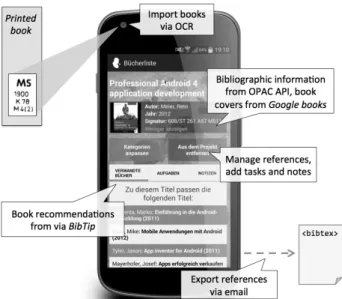ResearchSherlock 581
ResearchSherlock
Toward a Seamless Integration of Printed Books into the Digital Academic Workflow Maximilian Kautetzky, Benedikt Haas, Matthias Voit,
Manuel Burghardt, Christian Wolff
Media Informatics Group, University of Regensburg
{maximilian.kautetzky, benedikt.haas, matthias.voit}@stud.uni-regensburg.de, {manuel.burghardt, christian.wolff}@ur.de
1 Introduction and goals
With the increase of digital information practices (e.g. online search, desktop publishing, electronic reference management, etc.) in the academic context, printed books are sometimes cumbersome to integrate into the digital work- flow. We present ResearchSherlock, an Android app that allows the user to quickly gather bibliographic information for a printed book by scanning its shelfmark or ISBN. The application also provides recommenddations for thematically related books, to promote the discovery of other relevant books that are available in the local library.
2 Core functions and implementation details
ResearchSherlock is written in Java and is available for Android devices. All data is stored locally on the mobile device, in an SQLite database. Re- searchSherlock requires an Internet connection, as it makes use of a number
In: F.Pehar/C.Schlögl/C.Wolff (Eds.). Re:inventing Information Science in the Networked Society. Proceedings of the 14th International Symposium on Information Science (ISI2015),Zadar,Croatia,19th—21stMay 2015. Glückstadt:VerlagWerner Hülsbusch, pp. 581—583.
582 Poster Presentations
of web services and APIs. In its current implementation, ResearchSherlock is a prototype that works with books from the University Library of Regens- burg. In the following we describe core functions and implementation details (cf. fig. 1).
Figure 1. Screenshot of ResearchSherlock and core functions.
Import books via OCR
ResearchSherlock allows the user to store bibliographic data of printed books in a mobile application. Books can be imported into the app by scanning the book’s shelfmark, its ISBN (international standard book number) or BV (“Bestandsverzeichnis”) number. The scanning function utilizes the OCR (optical character recognition) service available from Google Drive1. The service processes an image and returns a text string as a result. We parse the returned string to make sure that it only contains valid characters of the ac- tual shelfmark, ISBN or BV. In case the OCR service does not work, the user may also enter the ISBN manually to import a book.
1 https://support.google.com/drive/answer/176692?hl=en <21.12.2014>
ResearchSherlock 583
Collect bibliographic information
Once the book has been imported, bibliographic information is collected from the OPAC (online public access catalog) API2. Book covers are ac- quired from Google books3. Via the bibtip4 service, it is also possible to get recommendations for other relevant books.
Manage and export references
In ResearchSherlock, users can create custom bibliographies and add digital notes or tasks to specific books. Eventually, bibliographic information of any book can be exported from ResearchSherlock in BibTeX format.
2 The OPAC API is kindly provided by the University Library of Regensburg.
3 https://books.google.com/ (last accessed on December 21, 2014) 4 http://www.bibtip.com/ (last accessed on December 21, 2014)
